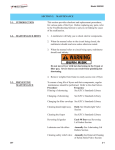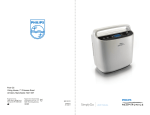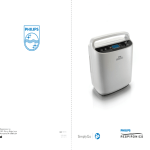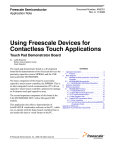Download EverGo user manual - Air Liquide Healthcare
Transcript
175010 AM 10/11/06 Table of Contents Introduction���������������������������������������������������������������������������������������������������� 1 Intended Use����������������������������������������������������������������������������������������������������������������������������������������1 Contraindications�������������������������������������������������������������������������������������������������������������������������������1 Package Contents ������������������������������������������������������������������������������������������������������������������������������2 Warnings and Cautions��������������������������������������������������������������������������������������������������������������������3 Symbol Key�������������������������������������������������������������������������������������������������������������������������������������������6 How to Contact Respironics�����������������������������������������������������������������������������������������������������������6 AC Grounding Instructions�������������������������������������������������������������������������������������������������������������7 Getting Started����������������������������������������������������������������������������������������������� 8 Battery Duration Times���������������������������������������������������������������������������������������������������������������������8 Inserting the Batteries�����������������������������������������������������������������������������������������������������������������������9 Charging the Batteries with AC Power Supply����������������������������������������������������������������������11 Operating the EverGo™ Device�������������������������������������������������������������������12 Starting the Device��������������������������������������������������������������������������������������������������������������������������13 Operating the Touch Screen��������������������������������������������������������������������������������������������������������15 Alarm Indicators and Screen Symbols��������������������������������������������������������19 Troubleshooting�������������������������������������������������������������������������������������������24 Caring for your Batteries �����������������������������������������������������������������������������25 Battery Storage����������������������������������������������������������������������������������������������������������������������������������25 Battery Disposal��������������������������������������������������������������������������������������������������������������������������������25 Caring for your EverGo Device �������������������������������������������������������������������26 Cleaning the Air Inlet Filter�����������������������������������������������������������������������������������������������������������26 Cleaning the Carrying Case�����������������������������������������������������������������������������������������������������������27 Device Storage����������������������������������������������������������������������������������������������������������������������������������27 Device Disposal���������������������������������������������������������������������������������������������������������������������������������27 Traveling With Your System������������������������������������������������������������������������28 Specifications������������������������������������������������������������������������������������������������30 Limited Warranty������������������������������������������������������������������������������������������32 Patents pending. EverGo is a trademark of Respironics, Inc. and its affiliates. © 2006 Respironics, Inc. and its affiliates. All rights reserved. EverGo User Manual Introduction The EverGo™ Portable Oxygen Concentrator, its features, and its accessories are described in detail in this manual. Read and understand it completely before operating the device. This manual applies to the following products: • EverGo Portable Oxygen Concentrator Device in Carrying Case • AC Power Supply • AC Power Cord • DC Power Cord • Rechargeable Lithium Ion Battery • Air Inlet Filter • Accessory Bag This manual does not apply to the following accessory items that are sold separately: • Mobile Cart • Standard Single Lumen Nasal Cannula • EverGo Smart Battery Charger/Recalibrator Intended Use The EverGo Portable Oxygen Concentrator is intended for prescription use by patients requiring high concentrations of oxygen on a supplemental basis. It is small, portable and is capable of continuous use in home, institutional, and travel / mobile environments. Contraindications This device is not intended to be life-sustaining or life-supporting. EverGo User Manual Package Contents The device comes with the following items. If any are missing, contact your equipment provider. • EverGo Device in Carrying Case with Detachable Handle and Shoulder Strap PN 900-000 (black) PN 900-002 (dark blue) • This User Manual PN 900-098 • Air Inlet Filter (located in zippered pouch on side of bag) PN 900-150 • Rechargeable Battery (2) PN 900-102 • AC Power Supply and Cord PN 900-105 • DC Power Cord PN 900-101 • Accessory Bag PN 900-250 EverGo User Manual Warnings and Cautions Caution: U.S. federal law restricts this device to sale by or on the order of a physician. Warnings A warning represents the possibility of harm to the operator or patient. • The operator should read and understand this entire manual before using the device. • The device is not intended for life support. Where the prescribing health care professional has determined that an interruption in the supply of oxygen, for any reason, may have serious consequences to the user, an alternate source of oxygen should be available for immediate use. • Geriatric, pediatric or any other patient unable to communicate discomfort, or hear or see the alarms while using this device, may require additional monitoring. • Oxygen supports combustion. Oxygen should not be used while smoking or in the presence of an open flame. • Do not use the device in the presence of a flammable anaesthetic mixture in combination with oxygen or air, or in the presence of nitrous oxide. • Do not use oil or grease on the concentrator or its components as these substances, when combined with oxygen, can greatly increase the potential for a fire hazard and personal injury. • If you notice any of the following, discontinue use and contact your home care provider: unexplained changes in the performance of this device, it is making unusual or harsh sounds, the device or the power supply are dropped or mishandled, water is spilled into the enclosure, or the enclosure is broken. • Repairs and adjustments must be performed by Respironics authorized service personnel only. Unauthorized service could cause injury, invalidate the warranty, or result in costly damage. • Periodically inspect electrical cords, cables, and the power supply for damage or signs of wear. Discontinue use and replace if damaged. EverGo User Manual Warnings (continued) • To avoid electric shock, unplug the device and remove the batteries before cleaning the bag. DO NOT immerse the device in any fluids. • Do not remove the device from the carrying case. Your home care provider is responsible for performing appropriate preventive maintenance at the intervals recommended by Respironics. • For proper operation, your device requires unobstructed ventilation. Always make sure filters and other openings in the case are not obstructed by items which may impede ventilation. Do not place the device in a small closed space (such as a closet). • Do not use an extension cord. Improper use of the grounding plug can result in a risk of electric shock. • Device operation above or outside of the voltage, breath rate, temperature, humidity and/or altitude values specified may decrease oxygen concentration levels. • Never drop or insert any object into any opening. • Be aware that the electrical cord and/or tubing could present a tripping or strangulation hazard. • This equipment has been tested and found to comply with all electromagnetic compatibility (EMC) requirements. These limits are designed to provide reasonable protection against electromagnetic interference in a typical installation. However, there is no guarantee that interference with other devices from electromagnetic emissions will not occur in a particular situation. Interference with other devices may be determined by turning the device off and on. Interference may be reduced by one or more of the following measures: - Reorient, relocate, or increase the separation between the devices. - Connect the equipment into an electrical outlet on a circuit different from that to which other devices are connected. EverGo User Manual Cautions A caution represents the possibility of damage to the equipment. • Do not immerse the device or allow any liquid to enter the enclosure. • When the device is used in an automobile, disconnect it from the DC auto adapter outlet when the automobile is turned off. Do not operate the device in a non-running vehicle for an extended period of time, as this may deplete the vehicle’s battery and prevent the vehicle from starting. Do not allow the device to be connected to the auto adapter outlet while starting the automobile normally or while you are starting the automobile with battery recharging cables. Wait until the automobile starts before connecting the device to the DC power outlet. Secure the device securely when used in any moving vehicle. (The same cautions apply if using the DC adaptor outlet on a boat or recreational vehicle.) • Turn off the device before removing the last remaining battery. The device should not be operated without the batteries installed. If the device is operated without the batteries installed, the standard shutdown routine will not be implemented when the power is disconnected prior to turning off the unit. This can result in damage to the device. • Only use the supplied handle and shoulder strap to carry your device. With every use, verify that the case, shoulder strap and handle are in good condition. Note: Additional warnings, cautions, and notes are located throughout the manual. EverGo User Manual Symbol Key Follow Instructions For Use Do not disassemble No smoking REF Model Number No oil or grease SN Serial Number How to Contact Respironics To have your device serviced, contact your home care provider. If you need to contact Respironics directly, call the Respironics Customer Service department at 1-800-345-6443 (U.S. and Canada only) or 1-724-387-4000. You can also use the following address: 1001 Murry Ridge Lane Murrysville, PA 15668 www.respironics.com Respironics and EverGo are a registered trademark and trademark, respe Respironics, Inc. and its affiliates. Patents Pending. © 2006 Respironics, In affiliates. All rights reserved. EverGo User Manual AC Grounding Instructions This product shall be grounded. In the event of an electrical short circuit, grounding reduces the risk of electric shock by providing an escape wire for the electric current. This product is equipped with a cord having a grounding wire with a grounded plug. The plug must be plugged into an outlet that is properly installed and grounded. Warning: Improper use of the grounding plug can result in a risk of electric shock. Warning: Do not connect this device to an electrical outlet controlled by a wall switch. If repair or replacement of the cord or plug is necessary, do not connect the grounding wire to either flat blade terminal. The wire with insulation having an outer surface that is green with or without yellow stripes is the grounding wire. Check with a qualified electrician or serviceman if the grounding instructions are not completely understood, or if in doubt as to whether the product is properly grounded. This product is for use on a nominal 120 V circuit and has a threeprong grounding plug that looks like the plug illustrated in (A) below. A temporary adapter, which looks like the adapter illustrated in (B) and (C), may be used to connect this plug to a 2-pole receptacle as shown in (B) if a properly grounded outlet (A) is not available. The temporary adapter should be used only until a properly grounded outlet can be installed by a qualified electrician. The green colored rigid ear, lug, and the like extended from the adapter must be connected to a permanent ground such as a properly grounded outlet box cover. Whenever the adapter is used, it must be held in place by the screw. Figure 1. Correct connection of power cord to the outlet. EverGo User Manual Getting Started Before using the batteries for the first time, the EverGo batteries require an initial uninterrupted charging time of 4 hours minimum. This can be accomplished by installing the batteries and using the AC Power Cord, as described in the following pages. Note: Respironics does not recommend using DC power for this initial charging. Caution: Use only Respironics batteries in your EverGo device. Using other batteries could damage the device and void the warranty. Battery Duration Times EverGo’s two-battery system gives it long operation duration times. For example, at a setting of 2 and 20 breaths per minute (BPM) with 2 fully charged batteries, the device can be expected to run for 8 hours. Likewise, under similar circumstances at a setting of 4, 5, or 6, it can run for 4 hours. The following table shows the approximate duration of use with two batteries at 20 BPM. Your times may vary based on your activity level and the condition of the batteries. Flow Setting 1 2 3 4 5 6 Breath Rate of 20 BPM 12 hours 8 hours 6 hours 4 hours 4 hours 4 hours Table 1. Approximate duration of the EverGo device operating with two fully charged batteries. Note: The duration times shown in the table above are based on a device using two fully charged batteries. If only one battery is used, duration will be approximately half of the times shown here. EverGo User Manual Inserting the Batteries Your EverGo device comes with two lithium ion batteries. To insert them correctly, follow these steps. 1. Place your device in a well ventilated location; make sure that the air inlet filter is properly in place. Note: The EverGo device is shipped from the factory with both batteries removed. Caution: Open the carrying case only when EverGo is turned off. Never open the case while the unit is operating. 2. Open the top of the carrying case using the zipper located underneath the flap surrounding the top part of the case, as shown here. If the device has been operating, the surfaces inside may be warm to the touch. This is normal. Figure 2. Opening the carrying case . 3. Check the fuel gauge for each battery. To do so, press the PUSH button on the battery and watch how many LEDs light up. If the batteries are low, you can recharge them. See page 11. No. of LEDs Battery Charge 4 LEDs Light: 75% to 100% full 3 LEDs Light: 50% to 75% full 2 LEDs Light: 25% to 50% full 1 LED Lights: 10% to 25% full PUSH 1 LED Blinks Battery is less than 3 Times: 10% full and needs to be recharged Figure 3. Battery Fuel Gauge EverGo User Manual 4. Gently insert both batteries into the battery compartments located on top of the device. Before inserting each battery, be certain that the battery connector on the bottom of the battery lines up with the arrow located next to the battery slot and the Respironics logo faces the inside of the device. Figure 4. Inserting the primary battery. 5. You may remove or insert your secondary battery using the small flap on the top of the carrying case to gain access to the battery compartment, shown here. Refer to the diagram under the flap which shows how the battery is inserted. Again, the Respironics logo should face the inside of the device. Figure 5. Inserting the secondary battery. 6. After the batteries are inserted, check to make sure each one is level with or slightly below the top of the plastic case. When fully inserted, the plastic retainer tab holds the battery in place. If either battery extends above the top gray surface, it may be in backwards. Remove it and insert it correctly. Do not force the battery. 7. Zip the case closed and keep it zipped during use. 8. Touch the screen once to verify that the battery symbols are visible. If you do not see battery symbols, one or both batteries have been inserted correctly. Reinsert them if necessary. Figure 6. Typical startup screen showing 2 batteries, each 3/4 charged. 10 EverGo User Manual Charging the Batteries with AC Power Supply Important: Do not use the DC Power Cord to charge the batteries for the first time. To charge the batteries using the AC Power Cord provided with your system, follow these steps. 1. Connect the output cable of the AC Power Supply to the EverGo power inlet. 2. Connect the connector of the AC Power Cord into the AC power supply. 3. Connect the plug of the AC Power Cord into a properly grounded AC outlet. (See the AC grounding instructions on page 7.) Figure 6. Connecting the power cord to the connector located under the Velcro flap. A typical battery charging screen is shown on the right Note: The AC Power Supply is equipped with a light indicator which lights up when it is connected to an energized AC power source. 4. When charging is complete (which takes a minimum of four hours for first use), disconnect the AC Power Supply and store it with the AC Power Cord for future use. Note: Replacement and spare batteries are available separately. For information, contact your home care provider. Note: An optional EverGo Smart Battery Charger/Recalibrator (sold separately) is available for your system. For more information, contact your home care provider. 11 EverGo User Manual Operating the EverGo Device You can use one battery, two batteries, AC power, or DC power to operate the device. Warning: Do not use the device without at least one battery installed and operating. • To use the batteries, first make sure they are properly inserted and fully charged. • To use AC power, follow these steps: 1. Connect the output cable of the AC Power Supply to the EverGo power inlet. 2. Connect the connector of the AC Power Cord into the AC power supply. 3. Connect the plug of the AC Power Cord into a properly grounded AC outlet. (See the AC grounding instructions on page 7.) Note: The AC Power Supply is equipped with a light, which illuminates when it is connected to an energized AC power source. • To use DC power from an automobile or other motorized vehicle, start the vehicle and connect one end of the DC Power Cord to the device’s power inlet and the other end into the vehicle’s DC electrical outlet. 12 EverGo User Manual Starting the Device To start your EverGo device, follow these steps. (The touch screen displays are discussed in detail beginning on page 15.) 1. Connect a nasal cannula to the oxygen outlet on top of your device, as shown here. Figure 7. The nasal cannula is connected to the oxygen outlet port. Note: A standard single lumen nasal cannula and tubing (not supplied) should be used to deliver oxygen from the EverGo device. The device works with cannula tubing up to 30 ft. (9.1 m). 2. To turn on the device, gently touch the screen. This first touch brings the screen to life and shows the on/off symbol. 3. Gently touch the on/off symbol to see the next screen. This “double touch” feature helps prevent unwanted starts or inadvertent changes in oxygen flow. Please note that you may touch Figure 8. Touch the on/off symbol to start. anywhere on the screen as your first touch. The second touch must be on the on/off symbol within 5 seconds. Note: If you touch the exact same spot twice, your device will not start. This feature reduces the chances that the device will be started by mistake. 4. To set the device’s flow setting, first touch the large number (such as the 2 shown here) in the center of the screen. Figure 9. Touch the number to change the flow setting 13 EverGo User Manual 5. Each time you press the flow setting number, an up arrow and/or down arrow will appear on the screen. (Examples are shown in Figures 16-17). To increase the flow setting, press the up arrow. To decrease the flow setting, press the down arrow. The device can be set to: 1, 1½, 2, 2½, 3, 3½, 4, 4½, 5, 5½, and 6. Warning: It is very important to set your device to your prescribed level of oxygen flow. Do not increase or decrease your flow rate from your prescribed level until you first consult with your physician. Note: When it is turned on, the device will automatically start at the flow rate setting used when the device was last turned off. As a precaution, each time you start the unit, verify the flow setting even though additional adjustments may not be necessary. Important: Every time it starts up, the device will quickly start producing higher oxygen concentration levels, but will not reach its specified purity for ten minutes. 6. Position the nasal cannula on your face, as shown below, and breathe normally through your nose. 14 Figure 10. Correct position of cannula on your face. EverGo User Manual Operating the Touch Screen You can change all device settings by gently touching the display screen, including starting the device, stopping it, silencing an alarm, and changing oxygen flow. The figures that follow explain the displays on your touch screen. The symbols and alarms shown on these screens are discussed in detail in pages 19-23 of this manual. Familiarize yourself with these pages before using the device. Note: Because all interaction with your EverGo device is through this touchsensitive interface, there are no knobs to turn or buttons to push. Simply touch the screen gently to operate the device. To start the device, touch anywhere on the blank screen. (When the device is in sleep mode, the screen is blank.) After the first touch, you will see a screen similar to the one shown below. secondary battery Primary battery ON/OFF SYMBOL Figure 11. Typical display after the first touch. Now touch the On/Off symbol shown above. Next, you will see the screen below, which indicates that the system is starting up. Flow Setting Primary Battery inserted and fully charged Pulse Symbol Figure 12. Typical display when the device is turned on. This screen shows that the flow setting is 1, and that the primary battery is inserted and fully charged. Because there is no symbol for the secondary battery on the left, this means the secondary battery is not inserted. Note: The dot next to the on/off symbol is the pulse symbol. It appears whenever you take a breath and the unit delivers a pulse of oxygen. 15 EverGo User Manual Secondary Battery is full Primary Battery is full Figure 13. This screen shows a flow setting of 1. The primary battery is inserted correctly and fully charged, and the secondary battery is inserted correctly and fully charged. Primary Battery is 3/4 full and charging DC Power Symbol Figure 14. This typical display shows the flow setting is 1, the primary battery (which is 3/4 or 75% charged) is inserted, and the device is connected to a power source. The secondary battery is not inserted. Secondary Battery is Full Primary Battery is charging Figure 15. This display shows that two batteries are inserted. It also shows that the unit is connected to a power source. The secondary (left) battery is fully charged. The primary (right) battery is nearly empty and charging. 16 EverGo User Manual Figure 16. To change the flow setting, touch the setting number (Here, it is the number 1). This causes the up flow change arrow to appear. To increase the flow setting, press the up arrow until you reach your prescribed setting. The flow setting arrow disappears 5 seconds after you touch it. For another example of the flow change arrows, see the next figure. Figure 17. To change the flow setting, touch the setting number; here it is 2 1/2. This causes the up and down arrows to appear. To increase the flow setting, press the up arrow on the right until you reach your prescribed setting. To decrease your flow setting, press the down arrow. The flow setting arrows disappear when you touch the number again or 5 seconds after you touch the screen. Flow Setting Symbol for No Breath Alarm An Audio Alarm has occurred Figure 18. Example of an alarm screen. If the device does not detect breathing for 30 seconds or more, it will sound the NB alarm and show this typical display with the NB alarm symbol (NB = No Breath). The alarm symbol (bell) shows the audio alarm is on. To silence the audio alarm, press the alarm symbol. For a complete list of alarms, see page 19. 17 EverGo User Manual The audio alarm has been silenced ON/OFF SYMBOL Figure 19. After pressing the alarm symbol (the bell), the audio alarm is silenced, though the alarm symbol remains on the screen as long as the condition remains. To correct an NB alarm, check your cannula tubing for kinks. For details about alarms, see page 19. To turn off the device, press the on/off symbol and then press the on/off symbol again as described in the next figure. Figure 20. Typical display after touching the On/Off symbol on the previous screen to turn off the device. You must press this symbol again, on this screen, to turn off this device. If this symbol is not pressed within 5 seconds, the previous screen will reappear and the device will remain on. Note: To stop the device, gently touch the on/off symbol twice, once on each of the last two screens (Figures 19-20). This “double touch” feature helps prevent unwanted stops or starts. 18 EverGo User Manual Alarm Indicators and Screen Symbols Visual, Audio Indicators 3 short beeps + 1 long beep 3 long beeps + 1 short beep 1 long beep Description What To Do No Breath Alarm This alarm occurs when a breath is not detected for a period of 30 seconds or more. This alarm can be silenced by pressing the “Alarm” symbol (the bell symbol shown on the left). This alarm becomes silent as soon as a breath is detected. If no breath is detected after approximately 5 minutes, the unit shuts down to conserve power. Check the connection from the cannula to the device. Make sure the nasal cannula is properly positioned on your face and that you are breathing through your nose. Make sure the cannula tubing is not kinked or obstructed. Oxygen Concentration Alarm This alarm occurs when the device is delivering a lower concentration of oxygen than specified. This alarm can be silenced by pressing the “Alarm” symbol (the bell symbol shown on the left). Change to another source of oxygen and contact your equipment provider. High Breath Rate Alarm This alarm indicates that the user’s breath rate is exceeding the capacity of the device. The device is still working properly and is still providing oxygen at a rate of 1.05 liters per minute. This alarm can be silenced by pressing the Alarm symbol (the bell symbol shown on the left). The alarm resets itself when breath rate is reduced. If this alarm occurs on a routine basis, contact your home care provider. 19 EverGo User Manual Visual, Audio Indicators 3 short beeps + 3 long beeps Symbol flashes 1 short beep 20 Description What To Do Technical Fault Alarm This alarm occurs when: a) the battery runs out or b) the device has a general malfunction and the unit is no longer operating properly. The device shuts down when this alarm occurs. Recharge the batteries and try to restart the device. If this alarm occurs again, change to another source of oxygen and contact your home care provider. Alarm Silenced Symbol This symbol appears when you press the bell symbol to silence the audible alarm. No further action is needed. Attention This symbol appears when corrective action is required. Allow the unit to warm up. Make sure it is in a warm location before operation. If this alarm continues, contact your home care provider. Low Battery Alarm The battery symbol flashes when approximately 17 minutes of battery life remains for the primary or secondary battery. Remaining battery life is dependent on your device settings and your activity level. Replace battery or connect to a power source. (Press bell symbol to silence the alarm.) EverGo User Manual Visual, Audio Indicators Description What To Do Depleted Battery Alarm This battery symbol flashes when approximately two minutes of battery life remains for the primary or secondary battery. Replace or recharge battery. (Press bell symbol to silence the alarm.) Battery Charging While Almost Empty Symbol This battery symbol appears (with the charging bars scrolling) when the battery is almost depleted and recharging. No action needed. Battery Charging While 75% (3/4) Full Symbol This battery symbol appears (with the charging bars scrolling) when the battery is 3/4 full and recharging. No action needed. Symbol flashes Alternating short and long beeps Battery Charge Complete Symbol 1 long beep This battery symbol appears when the battery is fully charged. No action needed. 21 EverGo User Manual Visual, Audio Indicators (Power Connection Symbol Disappears) 1 short beep 1st press = 1 long beep. 2nd press to turn device OFF = 3 long beeps 22 Description What To Do DC Power Connection Symbol This symbol appears when the device is connected to an AC or DC power source. No action needed. The Power Connection symbol disappears when the device is disconnected from the AC or DC power source. No action needed. On/Off Symbol This symbol appears when the device is powered ON, or is ready to be turned ON or OFF. Touch this symbol to turn the device on or off. Note: To prevent inadvertent starts and stops, the device requires two touches of the screen to turn it on and off. Pulse Symbol The dot next to the On/Off symbol appears when the unit delivers a pulse, whenever you take a breath. No action needed. EverGo User Manual Visual, Audio Indicators 1 short beep 1 short beep Description What To Do Sample Flow Control Setting This number shows the oxygen setting. It can range from 1 to 6. If this is your flow setting, no action is needed. If this is not your proper flow setting, touch the number to activate the arrows (shown below). Flow Control Change Arrows These arrow symbols appear after you touch the flow control setting number. They allow you to change the flow control setting. Touch the top arrow to increase the flow control setting. Touch the bottom arrow to decrease the flow control setting. 23 EverGo User Manual Troubleshooting The table below shows a list of common problems and actions you can take. If you are unable to resolve a problem, please contact your home care provider. Problem Possible Cause What You Should Do Device Won’t Turn On Batteries are depleted. Use the AC or DC power cords to operate the device (with the batteries inserted) to recharge the batteries. If this does not resolve the problem, contact your home care provider. Batteries are not installed correctly. Remove the batteries and install them correctly. Screen not touched twice. Touch the blank screen and then touch the On/Off symbol shown on the next screen. EverGo is not turned on. Touch the blank screen and then touch the On/Off symbol shown on the next screen. Cannula tubing is kinked or twisted. Make sure the tubing is connected properly to the oxygen outlet port and that it is free of any obstruction. Device Will Not Trigger A Pulse Of Oxygen Device malfunction. Contact your home care provider. Oxygen Not At Full Concentration Device is warming up. Wait 10 minutes for the device to deliver oxygen at the prescribed concentration. If the condition persists, contact your home care provider. Alarm Occurs The device needs your attention. See pages 19-23 for information about specific alarms and what you should do. 24 EverGo User Manual Caring for your Batteries Handle your batteries with care. • Do not allow a battery’s terminals to touch together as this will cause the battery to fail. • Do not immerse a battery in water. • Do not disassemble or deform a battery. • Do not expose to, or dispose of, a battery in fire. • Avoid exposing a battery to excessive physical shock or vibration (dropping, etc.). • Keep all batteries out of the reach of children. • Do not use any battery that has been damaged in any way. • Always charge the batteries in accordance with the manufacturer’s instructions, using specified chargers only. • Do not use modified battery chargers. Battery Storage Lithium ion batteries can be stored from -4° F (-20° C) to 140° F (+60° C) at up to 80% relative humidity. However, they are best stored below 70° F (21° C) in a cool, dry, well-ventilated facility free from corrosive gas or vapor. Storage at temperatures above 113° F (45° C) may degrade battery performance and reduce battery life. Storage at low temperatures may affect initial battery performance. Battery Disposal Dispose of the batteries in accordance with local regulations. 25 EverGo User Manual Caring for your EverGo Device Cleaning the Air Inlet Filter Respironics recommends that you clean the air inlet filter daily. Wash the air inlet filter, located in the zippered compartment on the end of the device case. Your home care provider may advise you to clean it more often depending on your operating conditions. Follow these steps to properly clean the air inlet filter. Figure 21 Removing the air inlet filter for cleaning. 1. Remove the filter, as shown above, and wash it in a solution of warm water and mild dishwashing detergent. 2. Rinse the filter thoroughly in warm water. Remove excess moisture by placing the filter in a soft absorbent towel and gently squeezing the filter dry. Allow it to air dry thoroughly. Ensure that the filter is completely dry before putting it back in the device. If you have a second air inlet filter on hand, insert this clean, dry filter into the carrying case while cleaning the dirty filter. 3. Place the dry filter in the zippered compartment and zip the compartment shut. Caution: Do not operate the device without the air inlet filter in place. 26 EverGo User Manual Cleaning the Carrying Case If cleaning is necessary, use only warm water and a mild dishwashing detergent. 1. Make sure the carrying case is closed. 2. Dampen a cloth in the detergent and water solution and wipe the outside surfaces of the case clean. Warning: Do not use alcohol, solvents, polishes or any oily substances on the device, as they are flammable. Caution: Do not allow liquids into any of the controls, the interior of the case, or the oxygen tubing connector. Should this happen, contact your home care provider for assistance. Device Storage Store your device in a place where it will remain clean and dry. Caution: Do not store your device or accessories in extreme temperatures, below -4° F (20° C) or above 140° F (60° C). Device Disposal Dispose of the device in accordance with local regulations. 27 EverGo User Manual Traveling With Your System With your EverGo system and proper advance planning, you can enjoy traveling within your community and beyond. Before you leave, make sure you pack the following: • • • Fully charged batteries (and extra batteries if it’s a long trip) AC power supply and connector cord DC power cord Also, be sure to take the telephone numbers of your home care provider and physician in case of an emergency. Note: The electrical outlets at many international destinations do not accommodate the standard U.S. style plug for this 110-volt device. If you have questions about the electrical outlet specifications for your trip, ask your home care provider for assistance. By Motor Vehicle Use the EverGo DC power cord to plug in your system using the vehicle’s cigarette lighter or DC power input. Whenever the EverGo system is running from a DC power source, the batteries installed in your unit will begin recharging. Caution: Make sure the vehicle has been started before plugging in your DC power cord. If you operate the EverGo system using the DC power cord while the vehicle engine is turned off, you could inadvertently drain the vehicle’s battery. 28 EverGo User Manual By Bus or Train Most bus and train lines allow passengers to use portable oxygen concentrators, but you may need to notify them in advance. When you make your travel arrangements, well before your departure, contact your carrier for permission to bring your system and use it on board. Note: Bus and rail carriers outside the United States may have additional requirements for oxygen concentrators. Contact them several weeks before you leave to identify any requirements or specifications that may require your attention. By Air When flying in the U.S. and abroad, commercial airlines may have unusual requirements for oxygen concentrators. Before you fly, contact all of your airlines on each of your connecting flights for permission to carry your EverGo system on board. Be sure to ask about any documentation you may need to bring with you. On the day of your flight, plan to arrive early. Security inspectors may need extra time to clear your luggage and oxygen system. For updated information about air travel with your EverGo device, visit our web site: www.evergo.respironics.com. On Arrival When you arrive at your destination, check the status of your system’s batteries. This is an excellent time to recharge all batteries, so they’re ready to go when you need them. If you have any questions or concerns about traveling with your EverGo system, contact your home care provider. 29 EverGo User Manual Specifications Operating Conditions Operational temperature: 40° F to 102° F (5° C to 40° C) Humidity: 15 to 95% RH Storage Conditions -4° F to 140° F (20° C to 60° C) - unit only Humidity: up to 80% RH, Non Condensing EverGo Oxygen Concentrator Oxygen Concentration* 89% Oxygen ± 3% at all settings Flow Settings and Pulse Volumes 1 = 12 ml; 1½ = 18 ml; 2 = 24 ml; 2½ = 29 ml; 3 = 35 ml; 3½ = 41 ml; 4 = 47 ml; 4½ = 53 ml; 5 = 58 ml; 5½ = 64 ml; and 6 = 70 ml. Maximum Capacity 1.05 LPM User Interface Touch screen, back lit liquid crystal display (LCD) Dimensions 12 in. long x 6 in. wide x 8.5 in. high (30.5 cm x 15.3 cm x 21.6 cm) Weight Less than 8.5 lbs. (3.86 kg) with 1 battery Less than 10 lbs. (4.6 kg) with 2 batteries Warm-up Time 10 minutes, prior to reaching specified oxygen concentration. Audio Alarm 50 decibels (nominal) at 39 in. (1 m) *Based on an atmospheric pressure of 14.7 psia (101 kPa) at 70° F (21° C) EverGo Battery Chemistry Lithium Ion 14.4 VDC (nominal) Dimensions 0.9 in. H x 6.6 in. L x 4.3 in. W (2.7 cm x 16.75 cm x 10.73 cm) Weight 1.5 lbs. (700 g) Battery Duration (when used together) 8 hours at a flow setting of 2, at 20 breaths per minute Charge Time Approximately 2-3 hours per battery from fully discharged to fully charged, depending on the power source and usage. 30 EverGo User Manual DC Power Supply Type Ault MW 116KA1800F06 Dimensions 0.75 in. x 1.5 in. x 2.36 in. (19 mm x 38 mm x 60 mm) Weight 18 oz. (500 g) Input: Input: 100 to 240 VAC, 50/60 Hz Output: Output: 18 VDC 5.0 A max 31 EverGo User Manual Limited Warranty Respironics, Inc. (“Respironics”) warrants the EverGo™ Portable Oxygen Concentrator System (the “Product”) as set forth in the following paragraphs. These warranties apply only to the original purchaser of the Product, who purchased the Product directly from Respironics as new merchandise. The warranties do not apply to any subsequent purchaser or user of the Product. Limited Warranty Respironics warrants that the Product, except as otherwise stated herein, is free from defects in materials and workmanship under normal and proper use and when correctly maintained in accordance with applicable instructions, for a period of two (2) years from the date of shipment by Respironics to the original purchaser (the “Warranty Period”). Products Not Under Warranty Accessories and replacement parts, including, but not limited to, filters and fuses, are not covered under this warranty. However, Respironics warrants that the battery in the Product will be free from defects in material and workmanship, under normal and proper use and when correctly maintained in accordance with applicable instructions, for a period of 90 days from the date of shipment by Respironics to the original purchaser. This warranty does not apply to batteries that are dropped, misused, altered or otherwise damaged after they are shipped. Limitations If any Product purchased from Respironics fails to conform to the warranties set forth herein during the Warranty Period, as determined by Respironics in its sole discretion, Respironics may discharge its warranty obligation by repairing or replacing the Product, in Respironics’ sole discretion. This may be accomplished by installing new or remanufactured assemblies or components, or by other repairs deemed appropriate in the sole discretion of Respironics. The choice of repair or replacement by Respironics shall be the sole and exclusive remedy of the original purchaser. Respironics reserves the right, in its sole discretion, to refund the purchase price in lieu of repair or replacement of the Product. In no event shall Respironics’ maximum liability under these warranties exceed the price paid to Respironics by the original purchaser for the Product. Conditions This warranty does not cover damage or injury whether to the Product or to personal property or persons caused by accident, misuse, abuse, negligence, failure to install in accordance with Respironics’ installation instructions, failure to operate under conditions of normal use and in accordance with the terms of the operating 32 manual and instructions, failure to maintain in accordance with the applicable service manuals, or alteration or any defects not related to materials or workmanship of the Product. This warranty does not cover damage which may occur in shipment. This warranty does not apply to any Product or individual part of a Product that may have been repaired or altered by anyone other than Respironics or an authorized Respironics service center. This warranty does not apply to any Product which is not purchased new. Exclusions of Warranties EXCEPT AS SET FORTH IN THIS LIMITED WARRANTY, RESPIRONICS MAKES NO WARRANTIES, EXPRESSED OR IMPLIED, STATUTORY OR OTHERWISE, REGARDING THE PRODUCT, ITS QUALITY OR PERFORMANCE. RESPIRONICS SPECIFICALLY DISCLAIMS THE IMPLIED WARRANTY OF MERCHANTABILITY AND THE IMPLIED WARRANTY OF FITNESS FOR A PARTICULAR PURPOSE. IN NO EVENT SHALL RESPIRONICS BE LIABLE FOR THE COST OF PROCUREMENT OF SUBSTITUTE PRODUCTS OR FOR ANY INDIRECT, SPECIAL, CONSEQUENTIAL, PUNITIVE, EXEMPLARY OR INCIDENTAL DAMAGES (INCLUDING, BUT NOT LIMITED TO, COMMERCIAL LOSS OR LOST REVENUES), FOR ANY CAUSE OF ACTION, WHETHER IN CONTRACT OR TORT, AND WHETHER OR NOT RESPIRONICS WAS AWARE OR SHOULD HAVE BEEN AWARE OF THE POSSIBILITY OF THESE DAMAGES. EXCEPT FOR THE OBLIGATIONS UNDER THIS LIMITED WARRANTY, RESPIRONICS SHALL NOT HAVE ANY OBLIGATION OR LIABILITY FOR ANY OTHER LOSS, DAMAGE OR INJURY RESULTING DIRECTLY OR INDIRECTLY FROM THE PRODUCT. PURCHASER’S SOLE AND EXCLUSIVE REMEDY FOR BREACH OF THE WARRANTIES SET FORTH IN THIS DOCUMENT SHALL BE AS PROVIDED IN THE PARAGRAPH DESCRIBING LIMITATIONS. Purchaser is cautioned that no person or entity is authorized to make any warranties on behalf of Respironics and any such alleged warranties are hereby disclaimed by Respironics. 1001 Murry Ridge Lane Murrysville, PA 15668











































